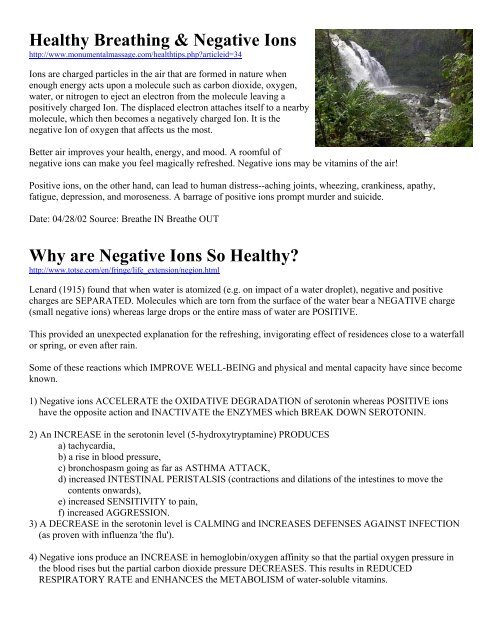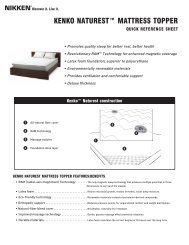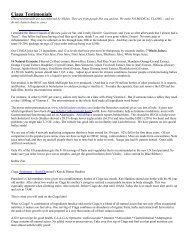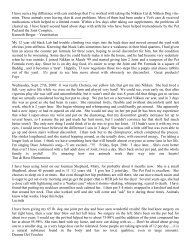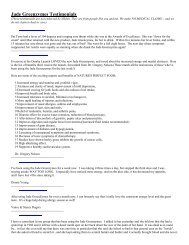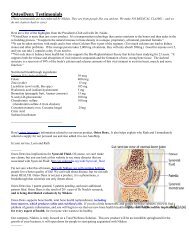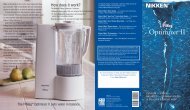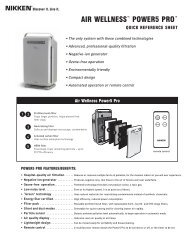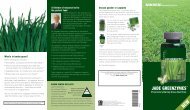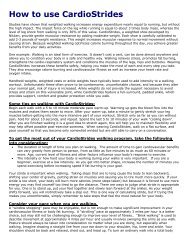Healthy Breathing & Negative Ions - Nikken Wellness Products ...
Healthy Breathing & Negative Ions - Nikken Wellness Products ...
Healthy Breathing & Negative Ions - Nikken Wellness Products ...
Create successful ePaper yourself
Turn your PDF publications into a flip-book with our unique Google optimized e-Paper software.
See Link: http://www.nalusda.gov/ttic/tektran/data/000008/54/0000085456.htmlJournal of HygieneScientists showed that ionization reduced bacterial levels in burns and plastic surgeryunits by over 96% after a two week period, which results in much better and more rapidhealing of patients.Journal of Applied MicrobiologyThe use of negative ions was even found by scientists to reduce the presence of airborneviruses by about 40%. A study featured in the 1987 issue also showed the negative ionsare free from any adverse side effects.<strong>Negative</strong> ions are needed in order to take in oxygen.Russian scientist, Dr. A. L. Tchijewsky, tried raising mice, rats, guinea pigs, andrabbits in totally de-ionized air. Almost all of them died within two weeks due to aninability to utilize oxygen properly (Tchijewski, 1960).Tchijewsky’s colleague, Dr. D. A. Lapitsky, tried raising small animals in air completelydevoid of oxygen. He added only negative ions to the air as they were about to die fromasphyxiation. At which point, their respiration frequency drastically increased, as theybegan to sit up and run around the chamber (Tchijewski, 1960).Former NASA scientist James B. Beal, who came across the negative ion problem whilestudying the type of environment needed in space capsules, wrote: "The human race wasdeveloped in ionized air. Nature used the ions in developing our biological processes."In other words, people have been designed to function properly in an environment thatcontains certain level of ionization (Soyka, 1991).Fred Soyka, author of "The Ion Effect" reports that based on the 5,000 plus scientificdocuments that have been published regarding negative ion studies, all support theconclusion that an overload of negative ions seems to be beneficial (Soyka, 1991).<strong>Negative</strong> ions counteract the effects of smoking.High levels of negative ions neutralize the effect that tobacco smoke has on the cilia.Cilia are the microscopic hairs located in the trachea that move rapidly back and forthto prevent pollutants and toxins from traveling into the vulnerable areas of therespiratory tract. The faster the cilia move, the more effective they are. However,tobacco smoke slows down the ciliary beat, diminishing the body’s ability to keep cancercausingpollutants from entering the depths of the respiratory tract. Tests have shownthough, that adding high levels of negative ions to the air accelerates the ciliary beatto normal levels (Soyka, 1991).<strong>Negative</strong> ions help prevent respiratory-related illnesses."I hope I’m in group one." In a study conducted in a Swiss textile mill, negativeionizers were placed in two, 60’ by 60’ rooms, each containing 22 employees. In one room,the negative ion electronic air cleaner was turned on during the course of the study. Inthe other room, the negative ion air purifier was permanently turned off, although theemployees in this room were led to believe they were working in a room enriched bynegative ions. During this six-month study, a total of 22 sick days were lost byemployees working in the room in which the negative ionizer was operating. In the roomwhere the machine was not operating, a total of 64 days were lost to sickness. During amonth-long flu epidemic, the first group lost a total of 3 days to sickness, while thesecond group lost a total of 40 days to sickness (Stark, 1971).In a test involving a Swiss bank office, one group of 309 worked in a negative iontreatedenvironment. A second group of 362 worked in an untreated environment. Over thenext several months, for every day lost to respiratory illness (cold, flu, laryngitis,etc.) in group one, 16 days were lost to respiratory illness in group two(Soyka, 1991).
In a Surrey University study at the Norwich Union Insurance Group headquarters, eightnegative ion generators were placed in the computer and data preparation section. Beforethe test, the research team spent a month compiling incident rates for complaints ofsickness and headaches. During the test in which the negative ion air purificationsystems were in operation, incidents of sickness and headaches were reduced by 78%. Aftertesting was completed, the Norwich Union opted to keep the negative ion electronic aircleaners (Soyka, 1991).<strong>Negative</strong> ions help prevent migraine headaches.Migraine headaches originate when an overload of serotonin causes the diameter of bloodvessels leading to the brain to dilate, and get wider in the brain. Consequently, bloodflow increases, and pain receptors in the vessels are stretched, which leads to theexcrutiating pain associated with a migraine headache (Borne, 1998; others). In numeroustests and studies though, negative ion treatment has proven to prevent the overproductionof serotonin, and therefore the subsequent migraine headaches (Kreuger, 1957; Soyka,1991; Sulman, 1974).<strong>Negative</strong> ions are a natural anti-depressant. . . . and without the side effects!In a study conducted by Columbia University, 25 people with SAD (Seasonal AffectiveDepression) sat in front of a negative ion air purifier for a half hour every morning fora month. Half the subjects were given a low level of negative ions, and the other half ahigh level. The higher level of negative ion treatment proved to be as effective againstSAD as antidepressants, such as Prozac and Zolof, and without the side effects of thesedrugs(Finley, 1996).Positive ions, which are found in abundance in most indoor environments, cause anoverproduction of serotonin. Serotonin is a neurotransmitter that helps the body dealwith mental, emotional, and physiological stress. An overproduction initially causeshyperactivity, which rapidly leads to anxiety, and in some cases depression. <strong>Negative</strong> iontreatment has proven to be successful in reducing the overproduction of serotonin, andtherefore successful in alleviating depression in some cases (Kreuger, 1957).<strong>Negative</strong> <strong>Ions</strong> Help Combat Fatigue.In 1957, a study published in the Journal of General Physiology concluded that negativeions reduce the overproduction of serotonin, a neurohormone that leads to exhaustion,among other things, when overproduced(Kreuger, 1957).<strong>Negative</strong> <strong>Ions</strong> Enhance Mental Performance and Concentration.The Alpha wave rythms say it all. In 1969, Dr. Sulman, head of the department of AppliedPharmacology at Hebrew University in Jerusalem at the time, brought in groups of peopleto spend some time in a room low in negative ions, and also in a room that contained an"overdose" of negative ions. While in each room, subjects were given word, figure, andsymbol tests. They scored "significantly higher" on these tests when they were in thenegative ion-enriched room. Plus, while in the negative ion room, they showed (via theelectroencephalogram) a slower, stronger pulse rate of Alpha waves from the brain. Alphawave rythms are a measure of the brain’s acitivity and health. A slow, strong Alpha wavepulse rate indicates healthiness, calmness, and heightened alertness. When the subjectswere in the negative ion-deficient room, they showed signs of irratibility and fatigue inaddition to lower test performance (Sulman, 1974).In the study conducted by Surrey University at the Norwich Union Insurance Groupheadquarters, the employees in the computer and data preparation section that wereexposed to high levels of negative ions showed a 28% increase in overall taskperformance. The more difficult the task, the more dramatic the improvement tended to be(Soyka, 1991).In 1972 in Geneva, statistics showed that whenever there was a drastic change in theweather, and a consequent drop in the negative ion concentration in the air, trafficaccident rates rose by more than 50% (Soyka, 1991).
<strong>Negative</strong> ions enhance physical performance.After World War II, the Russians extensively studied the relationship between negativeions and physical performance. A team of doctors, psychologists, and physicists observedand measured the performance of Olympic athletes in various conditions of negative ionslevels. In each test of physical performance, the group that trained in facilities, andstayed in quarters high in negative ion concentration showed tremendous improvements inperformance in comparison to the control group (Minkh, 1961).In 1969, French researcher found that the overproduction of the neurohormone serotonincaused sleeplessness and nightmares. In using a negative ion electronic air cleaner totreat a group of people experiencing sleeping problems as a result of serotoninoverproduction, he found that most of them were able to sleep better (Soyka, 1991).<strong>Negative</strong> ions aid in the treatment of burn patients.In 1959, Dr. Kornbleuh treated a group of 138 burn victims at Northeastern GeneralHospital with negatived ionized air. Within this group, 57.3% suffered significantly lesspain and discomfort, while healing more quickly and thoroughly. Only 22.5% of the controlgroup (the group of burn victims treated through conventional methods rather thannegative ionization) experienced similar improvements in the same time frame.Statistically, the odds are 1,000 to 1 that these results were coincidental. This study,along with other follow up tests, were evidence enough for the hospital, whichsubsequently equipped its postoperative wards with negative ion generators. Theeffectiveness of negative ion treatment in these tests are likely a result of theextraordinary ability of negative ions to remove pollutants from the air, resulting inreduced infection and irritation of burn wounds (Kornbleuh, 1959).BibliographyAmerican Academy of Allergy, Asthma, and Immunology (1998). AAAAI Patient/Public ResourceCenter(www.aaaai.org).Boguslaw, Maczynski, & Falkiewicz, B. (1973). "Effects of Various Ionizing Factors on theConcentration of Condensation Nuclei in the Air of an Office Room". BalneoclimatologicalInstitute in Poznan, Poland.Finley, M. (1996). "The PC Blahs: Do You Have Ion-Poor Blood?". Future Shoes(wwwskypoint.com).Kornbleuh, Igho, M. D., et al. (1959). "Polarized Air as an Adjunct in the Treatment ofBurns". Philadelphia: Northeastern Hospital.Kreuger, A. P. (1957). "The Action of Air <strong>Ions</strong> on Bacteria". Journal of GeneralPhysiology. Berkeley: University of California.Kreuger, A. P. (1957). "The Biological Mechanisms of Air Ion Action". Journal of GeneralPhysiology. Berkeley: University of California.Kreuger, A. P. (1974). "The Influence of Air <strong>Ions</strong> on a Model of Respiratory Disease".Paris: Proceedings of the World Congress of Medicine and Biology of the Environment.Laws, C. A., & Holiday, E. R. (1975). "Air <strong>Ions</strong> in Physical Medicine and EnvironmentalHygiene". Proceedings of the Symposium of the British Society of Environmental Engineers.Minkh, A. A. (1961). "The Effect of Ionized Air on Work Capacity and Vitamin Metabolism".Journal of the Academy of Medical Sciences, U.S.S.R. (Translated by U.S. Department ofCommerce, Washington, D.C.).Soyka, F. (1991). The Ion Effect. Bantum Premium, U.S.


